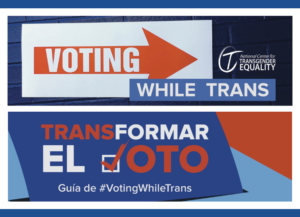Voting While Trans? Take This Checklist With You
In the run-up to the midterm elections, there’s been much talk about voter ID laws. A majority of states—34, to be exact—will request or require ID to vote on Tuesday, November 6. One effect of such laws could prevent up to 78,000 transgender people from voting due to barriers around matching names and gender markers on their IDs.

If you’re transgender, it is essential that you understand your state’s voter identification laws and what to do if your right to vote is challenged.
The National Center for Transgender Equality created this Voting While Trans Checklist to use before and on Election Day (also available in Spanish). Here’s a rundown of the steps to take if your right to vote is challenged.
1. Make sure to bring proper ID.
Check the interactive map at Election Protection, aka 866OurVote. Once you select your state of residence, you’ll see state-specific voting information, including identification requirements.
It’s a good idea to bring your voter registration card (with the name and address that match your ID) a utility bill with the same information (if possible), and the Voting While Trans Checklist.
2. Show ID if asked to do so.
If poll workers challenge your identity or eligibility to vote, show them the additional information that you brought. The second page of the Voting While Trans Checklist contains a section called “Information for Poll Workers and Election Officials.”
3. Seek help from a volunteer attorney.
There may be volunteer attorneys on site at the polling center who are there to help voters who are facing challenges regarding their eligibility to vote.
4. Call the National Election Protection Hotline.
If you are still unable to vote, call the National Election Protection Hotline at 866-OUR-VOTE (866-687-8683). Election Protection is a national, nonpartisan organization with a mission to guarantee that there is an equal opportunity for all voters to engage in the political process.
5. Still unable to vote?
Request a provisional ballot. Rules vary state from state, but regardless of where you live, you must be given a provisional ballot and a receipt if you request one.
Make sure to ask for follow-up instructions. In order for your vote to be counted, you may need to return to election officials in the near future to prove your identity.
Don’t forget: Join your fellow LGBTQ+ voters and stand up for your rights on Tuesday, November 6.
This post is part of a series by SAGE about voting as it relates to issues that matter to older LGBTQ+ people.







